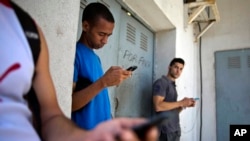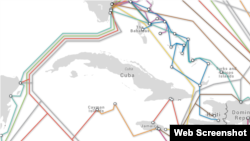When Cubans learned of their government’s new relationship with the United States last week, it’s likely almost none of them read about it online.
Access to the Web is severely limited, extremely slow and priced beyond what most Cubans can afford. And that’s even before considering the massive censorship of content and persecution of bloggers critical of the regime.
Perhaps it’s no surprise that high on the Obama administration’s new priority list for Cuban-U.S. relations is to see the island nation more fully connected to the World Wide Web, as well as pushing for increased freedom of access and speech.
But if the Internet is going to be one of the principal tools for changing Cuba, the very first task is now connecting a nation largely left behind in the digital revolution.
11 million citizens
Despite the U.S. embargo, Cuban officials like to tout that all 11 million Cuban citizens have free and unrestricted access to education, housing and medicine.
But for years that same access has been all but absent for the Internet and other digital forms of communication like mobile phones.
The United Nation’s International Telecommunications Union estimates that only about 25 percent of Cubans have access to the Internet - up from nearly zero in 2000. But that number only represents the percent that potentially has access; many estimates say the real percentage is much lower.
Researchers at Freedom House, an independent NGO focused on issues of expanding freedoms, estimate that actual Internet penetration for 2011 was only 5 percent, making the nation one of the least connected in the world.
Access to devices is also a problem.
In 2008, Havana began to allow the purchase of some mobile phones and computers for private use. However, five years later the ITU estimates that only 17 percent of Cubans have access to mobile phones, with nearly all of them only second-generation devices that don’t support Web access. The percentage of households with a computer is far lower.
There are a few cyber cafes in Cuba, but cost becomes another access problem.
The group Reporters Without Borders, which has declared Cuba an “enemy of the Internet,” estimates that it costs on average the equivalent of $5 to $7 for a half-hour connection to the Internet. But that the average monthly salary in Cuba equals only $20, making frequent access prohibitive.
Getting online is only half the problem for Cubans. The other, and more problematic issue, is the rigid control the government exerts over what people can see and say while online. Particularly in the government’s crosshairs are Cuban bloggers who openly criticize the regime.
In 2012, following a brief period where the government appeared to ease restrictions, Havana again cracked down, shuttering a range of blogs and websites, restricting access to email content at work, and jailing a number of cyber activists and critics.
Among the prominent Cuban bloggers that have tangled with the government is Yoani María Sánchez, lead author of the “Generación Y” blog.
While never jailed, Sanchez remains a thorn in the side of the Castros and her blog is blocked within Cuba. (She publishes it by sending blog entries to friends outside Cuba, who then post it on non-Cuban servers.)
As for content coming from outside of Cuba, the government routinely employs an unsophisticated series of blocks on thousands of websites. While these blocks are fairly easy to bypass, the government may have decided that the lack of access to the Web makes these sites relatively harmless.
Mystery cable
While much of Latin America has been busily building greater connections to the world via the Internet, Cuba is almost completely cut off.
Much of the globe’s data traffic flows through undersea fiber-optic cables, transmitting enormous amounts of information and linking countries and continents together in what we know as the Web.
But a look at the map of global submarine cables provided by Global Bandwidth Research Service clearly shows that while most of the Caribbean and Latin America is connected through dozens of cables, all but one completely bypass Cuba.
And that cable, the ALBA-1, may have in fact lain dormant until a U.S.-based researcher discovered its existence.
In 2011, the ALBA-1 cable was quietly strung between La Guaira, Venezuela and Siboney, Cuba. (It has since been extended from Cuba to Jamaica.)
Owned by Telecom Venezuela, for several years it remained mysteriously quiet until 2013, when Doug Madory, a research analyst with Dyn Research, noticed it was suddenly turned on.
While the ALBA-1 greatly increased the amount of data that could flow to Cuba, Madory cautions that the Castro regime still is in control of just how much will.
“Yesterday’s historic agreement to begin normalizing relations between Cuba and the United States contains a pledge by the Cuban government to ‘greatly expand its citizens’ access to the Internet,’ ” Madory wrote last week on his blog. “What exactly this pledge entails will determine how the Internet evolves in Cuba in the near term.
“Decision makers in Cuba should look at another country that recently opened up its telecom sector and is presently experiencing an explosion in Internet growth: Myanmar,” he wrote.
'Lighting up the island'
While it’s unknown yet how the new U.S.-Cuba relationship will affect access to an uncensored Internet for the island’s 11 million residents, it’s clear that Washington is making this a top priority.
“I believe in the free flow of information,” President Barack Obama said when he unveiled his new Cuba policy. “Unfortunately, our sanctions on Cuba have denied Cubans access to technology that has empowered individuals around the globe."
That’s leading many to believe the Obama administration will push as hard as it can for Cuban officials to open up the island to telecommunications companies looking to build out increased Internet fiber and mobile data access.
“The government here did its best to restrict the flow of information,” Jeffrey DeLaurentis, the U.S.'s highest-ranking official in Cuba, told the CBS TV program “60 Minutes” this Sunday. “And they have committed to providing more access to the Internet to the Cuban people.
“We believe that lighting up the island is going to make a major change here," DeLaurentis said.
While it’s likely the Cuban government will seek to expand its digital and mobile capacity, that may not mean that Cubans will readily adopt U.S.-style websites and social media.
Sujatha Fernandes and Alexandra Halkin with the National American Congress on Latin America, or NACLA, write that some Cubans have already begun building their own alternative network for sharing information and commentary.
Called “El Paquete Seminal,” or the Weekly Packet, it’s a 1 terabyte eclectic compilation of all sorts of media: current movies, YouTube clips, technology reports, Cuban and international news and much more. This packet is then circulated hand-to-hand across the island - sort of a samizdat for the digital age.
However it develops, blogger Sánchez is optimistic the changing U.S.-Cuba policy will lead to greater freedom for those who want to read or write the kind of material found in “Generación Y.”
“Today was a political defeat,” she writes of the Cuban government’s new stance to the United States. “David can’t live without Goliath and the ideological apparatus has depended too long on this dispute.”












